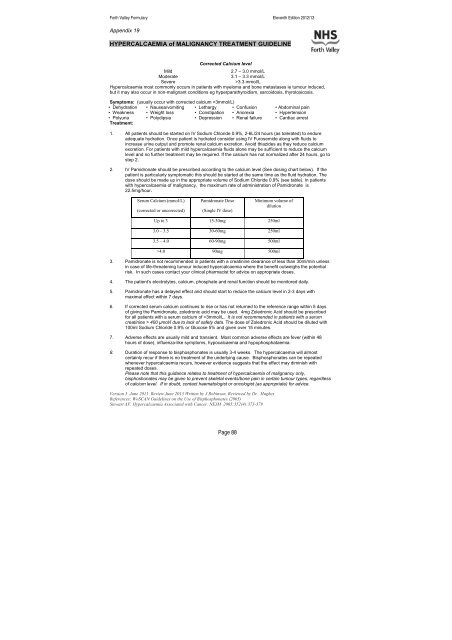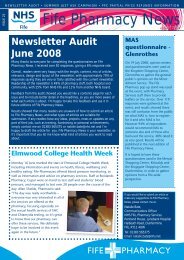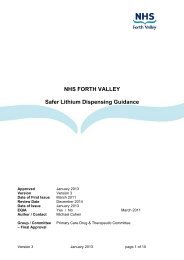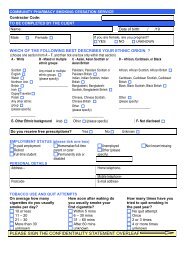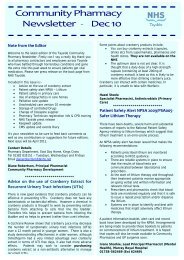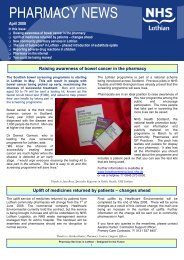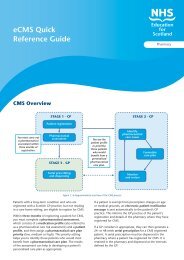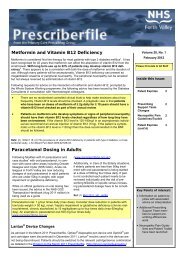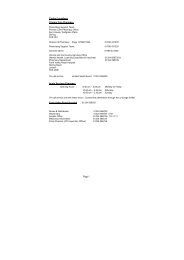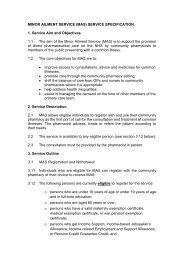nhs forth valley formulary 11 - Community Pharmacy
nhs forth valley formulary 11 - Community Pharmacy
nhs forth valley formulary 11 - Community Pharmacy
You also want an ePaper? Increase the reach of your titles
YUMPU automatically turns print PDFs into web optimized ePapers that Google loves.
Forth Valley Formulary Eleventh Edition 2012/13Appendix 19HYPERCALCAEMIA of MALIGNANCY TREATMENT GUIDELINECorrected Calcium levelMild2.7 – 3.0 mmol/LModerate3.1 – 3.3 mmol/LSe vere>3.3 mmol/LHypercalcaemia most commonly occurs in patients with myeloma and bone metastases ie tumour induced,but it may also occur in non-malignant conditions eg hyperparathyroidism, sarcoidosis, thyrotoxicosis.Symptoms: (usually occur with corrected calcium >3mmol/L)• Dehydration • Nausea/vomiting • Lethargy • Confusion • Abdominal pain• Weakness • Weight loss • Constipation • Anorexia • Hypertension• Polyuria • Polydipsia • Depression • Renal failure • Cardiac arrestTreatment:1. All patients should be started on IV Sodium Chloride 0.9%, 2-6L/24 hours (as tolerated) to endureadequate hydration. Once patient is hydrated consider using IV Furosemide along with fluids toincrease urine output and promote renal calcium excretion. Avoid thiazides as they reduce calciumexcretion. For patients with mild hypercalcaemia fluids alone may be sufficient to reduce the calciumlevel and no further treatment may be required. If the calcium has not normalized after 24 hours, go tostep 2.2. IV Pamidronate should be prescribed according to the calcium level (See dosing chart below). If thepatient is particularly symptomatic this should be started at the same time as the fluid hydration. Thedose should be made up in the appropriate volume of Sodium Chloride 0.9% (see table). In patientswith hypercalcaemia of malignancy, the maximum rate of administration of Pamidronate is22.5mg/hour.Serum Calcium (mmol/L)(corrected or uncorrected)Pamidronate Dose(Single IV dose)Minimum volume ofdilutionUp to 3 15-30mg 250ml3.0 – 3.5 30-60mg 250ml3.5 – 4.0 60-90mg 500ml>4.0 90mg 500ml3. Pamidronate is not recommended in patients with a creatinine clearance of less than 30ml/min unlessin case of life-threatening tumour induced hypercalcaemia where the benefit outweighs the potentialrisk. In such cases contact your clinical pharmacist for advice on appropriate doses.4. The patient’s electrolytes, calcium, phosphate and renal function should be monitored daily.5. Pamidronate has a delayed effect and should start to reduce the calcium level in 2-3 days withmaximal effect within 7 days.6. If corrected serum calcium continues to rise or has not returned to the reference range within 5 daysof giving the Pamidronate, zoledronic acid may be used. 4mg Zoledronic Acid should be prescribedfor all patients with a serum calcium of >3mmol/L. It is not recommended in patients with a serumcreatinine > 400 μmol/l due to lack of safety data. The dose of Zoledronic Acid should be diluted with100ml Sodium Chloride 0.9% or Glucose 5% and given over 15 minutes.7. Adverse effects are usually mild and transient. Most common adverse effects are fever (within 48hours of dose), influenza-like symptoms, hypocalcaemia and hypophosphataemia.8. Duration of response to bisphosphonates is usually 3-4 weeks. The hypercalcaemia will almostcertainly recur if there is no treatment of the underlying cause. Bisphosphonates can be repeatedwhenever hypercalcaemia recurs, however evidence suggests that the effect may diminish withrepeated doses.Please note that this guidance relates to treatment of hypercalcaemia of malignancy only,bisphoshonates may be given to prevent skeletal events/bone pain in certain tumour types, regardlessof calcium level. If in doubt, contact haematologist or oncologist (as appropriate) for advice.Version 5 June 20<strong>11</strong> Review June 2013 Written by J Robinson. Reviewed by Dr. HughesReferences: WoSCAN Guidelines on the Use of Bisphosphonates (2005)Stewart AF. Hypercalcaemia Associated with Cancer. NEJM 2005;352(4):373-379Page 88


